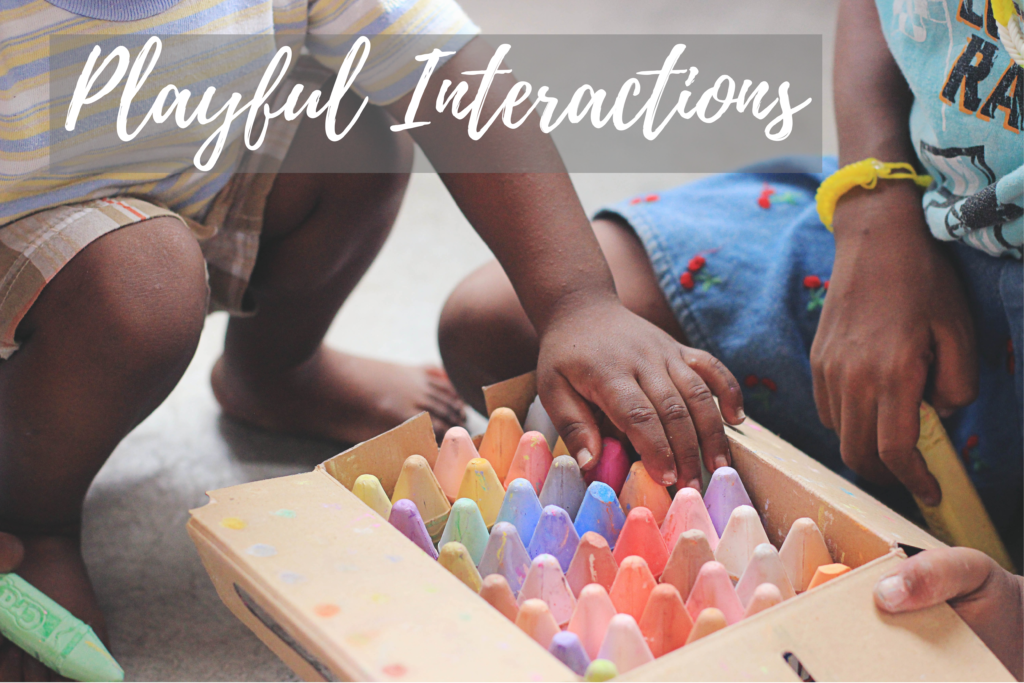 Play is critical to the development of every child. Child psychologist, Dr. David Cross, says that we can think of playfulness as an investment. The more playfulness is a part of your everyday interactions with your kids and teens, the more investment you put into the relationship. This investment yields the returns of improved physical, mental, and emotional health for both you and your child, plus it’s fun. Additionally, this continued investment gives your relationship with the resiliency to handle those moments where you aren’t fully present with your child.
Play is critical to the development of every child. Child psychologist, Dr. David Cross, says that we can think of playfulness as an investment. The more playfulness is a part of your everyday interactions with your kids and teens, the more investment you put into the relationship. This investment yields the returns of improved physical, mental, and emotional health for both you and your child, plus it’s fun. Additionally, this continued investment gives your relationship with the resiliency to handle those moments where you aren’t fully present with your child.
Playful Interaction
Nothing comes more natural to a child than play. Research done by the Karyn Purvis Institute for Child Development tells us that play disarms the fear response system, builds connectedness, and gives children the ability to develop skills for life, such as learning to trust, problem-solve, and interact with others.
Play is foundational for forming a deep emotional bond between the caregiver and child, the roots of which begin at birth. Those first moments with your newborn doing things such as playing peek-a-boo, blowing on your baby’s belly, or making your baby laugh by making silly faces or noises are the moments that are building the foundation for your child to develop emotional control and self-regulation throughout their life. It is in the ebb and flow of playful interactions that you are learning how to respond to your child’s needs in a way that instills a sense of being understood in them. In turn, having these moments of attuned responses from caregivers paves the way for your child to be the kind of person who can recognize and make sense of his/her own feelings, as well as respond to the feelings and needs of others.
So, what does the playful interaction look like?
It depends on the personality of your child. It can include rough and tumble activities like playful wrestling, sports, play with water or nerf guns, or it can be more warm and interactive including activities like cuddling on the couch and watching a movie or reading a book together or playing a board game with each other. Any of these activities are wonderful for connecting; however, the kind of playful interaction that stimulates the most growth is unstructured play. During unstructured play, your child’s imagination is free to run wild, and they can discover their own interests and passions, growing their capacity to exercise their autonomy and develop a sense of self.
A great way to implement this type of unstructured play aimed at playful interaction is by taking 10-15 minutes a day to give your child the gift of your complete attention and full presence. During this time, the child has the opportunity to be the leader and decide what activity or game they would like to do. The four rules of this interaction are:
- Let the child lead
- No teaching
- No questioning
- No instructing
During this 10-15 minutes, you get to join with them in whatever activity they choose, letting them lead, while aiming to notice, validate, and delight in your child.
Voice Quality
How we say what we say is just as important as what we are actually saying. How many misunderstandings and power struggles happen because of the quality of our voice and our kids’ voices when we communicate. Dr. Purvis uses the concept of Total Voice Control and the acronym TVC as a tool to explain the importance of the parent’s voice when connecting with your child.
The T stands for tone. There is a difference between having a harsh tone and a firm tone to communicate a message to your child. There are plenty of times in the parent-child relationship when we have to communicate things with a sense of firmness, especially in the face of kids pushing back against limits or boundaries; however, often when we think we are just being firm, we are actually being harsh, which might put a stop to the behavior that we don’t like in our child, but it undermines the relationship and leaves us feeling disconnected afterward.
The V stands for volume. Have you ever heard your child say, “mommy or daddy, stop yelling at me!” As adults, our voices naturally carry more power with them, and when we feel as though we are being challenged, our voices have greater intensity and perhaps are indeed louder than we even realize, which comes across as scary to our children. This can provoke a fear response from them, escalating into a fight, flight, or freeze response to them.
The C stands for cadence. This part of the TVC acronym is aimed at the rhythm of your voice — the sing-song melodic quality that we typically think of when it comes to interacting with younger kiddos. As our kids get older, we begin talking to them like they are adults, which can come across as robotic, monotone, or business-like, all of which make it less likely that our kids will hear what we are saying to them, and it will also be not readily seen as a bid for engagement and connection. Instead, we want to bring some playfulness back into our voices no matter what age because playfulness is disarming. With older kids and teens, this will look different than with a 5-year-old, however, we still want to retain playfulness with the way we talk to our kids no matter what age.
In order to increase your awareness of what your voice sounds like with your kids, I would encourage you to record yourself throughout the day in your interactions with your kiddos to see what your voice sounds like when you’re interacting with them.
Oftentimes when we start to examine our ways of relating to our kids, it’s normal that our own histories with our caregivers will resurface even with reflecting on something that seems as small as eye contact or voice quality. We might be flooded with memories of our own experiences of being on the receiving end of harsh looks or words, and if that happens, I would invite you to reflect on your own experiences with a trusted person who can hold your personal experiences of woundedness in a safe and compassionate manner, whether that would be with a spouse, friend, or therapist. These playful interactions developed out of TBRI® principles will help you and your child create intentional connections that will last a lifetime.
